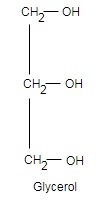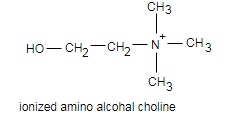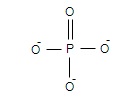
Chemistry: An Introduction to General, Organic, and Biological Chemistry (12th Edition) - Standalone book
12th Edition
ISBN: 9780321908445
Author: Karen C. Timberlake
Publisher: PEARSON
expand_more
expand_more
format_list_bulleted
Question
Chapter 15.5, Problem 15.40QAP
Interpretation Introduction
Interpretation:
Draw the condensed structural formula for the glycerophosphalipid lecithin that contains two molecules of palmitic acid and the ionized amino alcohol choline.
Concept introduction:
Palmitic acid and glycerol are connected by ester bond formation; the remaining one  group of glycerol is connected to phosphate.
group of glycerol is connected to phosphate.


Palmitic acid

Phosphate


Expert Solution & Answer
Want to see the full answer?
Check out a sample textbook solution
Students have asked these similar questions
Please draw a stepwise mechanism for this reaction.
Please show full mechanism for this equation, all arrows and resonance. I would like to see the mechanisms for para, ortho, and meta positions! Thank you
1
Please provide an efficient synthesis of the product below from the starting material.
Use the starting material as the ONLY source of carbon atoms. Show the synthesis of each compound
that would be used in the overall synthesis of the product.
[This synthesis uses alkyne and alcohol chemistry.]
Chapter 15 Solutions
Chemistry: An Introduction to General, Organic, and Biological Chemistry (12th Edition) - Standalone book
Ch. 15.1 - Prob. 15.1QAPCh. 15.1 - Prob. 15.2QAPCh. 15.1 - Lipids are not soluble in water. Are lipids polar...Ch. 15.1 - Which of the following solvents might be used to...Ch. 15.2 - Describe some similarities and differences in the...Ch. 15.2 - Prob. 15.6QAPCh. 15.2 - Prob. 15.7QAPCh. 15.2 - Draw the line-angle formula for each of the...Ch. 15.2 - Prob. 15.9QAPCh. 15.2 - For each of the following fatty acids, give the...
Ch. 15.2 - Prob. 15.11QAPCh. 15.2 - How does the double bond influence the dispersion...Ch. 15.2 - Prob. 15.13QAPCh. 15.2 - Prob. 15.14QAPCh. 15.2 - Prob. 15.15QAPCh. 15.2 - Prob. 15.16QAPCh. 15.2 - Prob. 15.17QAPCh. 15.2 - Prob. 15.18QAPCh. 15.3 - Draw the condensed structural formula for the...Ch. 15.3 - Prob. 15.20QAPCh. 15.3 - Prob. 15.21QAPCh. 15.3 - Draw the condensed structural formula for a mixed...Ch. 15.3 - Prob. 15.23QAPCh. 15.3 - Prob. 15.24QAPCh. 15.3 - Prob. 15.25QAPCh. 15.3 - Prob. 15.26QAPCh. 15.4 - Identify each of the following processes as...Ch. 15.4 - Identify each of the following processes as...Ch. 15.4 - Prob. 15.28QAPCh. 15.4 - Prob. 15.29QAPCh. 15.4 - Prob. 15.30QAPCh. 15.4 - Prob. 15.31QAPCh. 15.4 - Prob. 15.32QAPCh. 15.4 - Prob. 15.33QAPCh. 15.4 - Prob. 15.34QAPCh. 15.4 - Prob. 15.35QAPCh. 15.4 - Draw the condensed structural formula for all the...Ch. 15.5 - Prob. 15.37QAPCh. 15.5 - Prob. 15.38QAPCh. 15.5 - Prob. 15.39QAPCh. 15.5 - Prob. 15.40QAPCh. 15.5 - Prob. 15.41QAPCh. 15.5 - Prob. 15.42QAPCh. 15.5 - Prob. 15.43QAPCh. 15.5 - Prob. 15.44QAPCh. 15.6 - Draw the structure for the steroid nucleus.Ch. 15.6 - Draw the structure for cholesterol.Ch. 15.6 - Prob. 15.47QAPCh. 15.6 - Prob. 15.48QAPCh. 15.6 - Prob. 15.49QAPCh. 15.6 - Prob. 15.50QAPCh. 15.6 - Prob. 15.51QAPCh. 15.6 - Prob. 15.52QAPCh. 15.6 - Prob. 15.53QAPCh. 15.6 - What are the similarities and differences between...Ch. 15.6 - Prob. 15.55QAPCh. 15.6 - Prob. 15.56QAPCh. 15.7 - What is the function if the lipid by layer in a...Ch. 15.7 - Prob. 15.58QAPCh. 15.7 - Prob. 15.59QAPCh. 15.7 - How do the unsaturated fatty acids in the...Ch. 15.7 - Prob. 15.61QAPCh. 15.7 - Prob. 15.62QAPCh. 15.7 - Prob. 15.63QAPCh. 15.7 - 15.66 Identify the type of transport described by...Ch. 15 - Prob. 15.65UTCCh. 15 - Prob. 15.66UTCCh. 15 - Prob. 15.67UTCCh. 15 - Prob. 15.68UTCCh. 15 - Prob. 15.69AQAPCh. 15 - Prob. 15.70AQAPCh. 15 - Prob. 15.71AQAPCh. 15 - Prob. 15.72AQAPCh. 15 - Prob. 15.73AQAPCh. 15 - Prob. 15.74AQAPCh. 15 - Identify each of the following as a fatty acid,...Ch. 15 - Identify each of the following as a fatty acid,...Ch. 15 - 15.81 Identify the components (1 to 6 ) contained...Ch. 15 - Prob. 15.78AQAPCh. 15 - Prob. 15.79AQAPCh. 15 - Prob. 15.80AQAPCh. 15 - Draw the condensed structural formula for a...Ch. 15 - sunflower seed oil can be used to make margarine....Ch. 15 - 15.89 A sink drain can become clogged with solid...Ch. 15 - 15.90 One of the triacylglycerols in olive oil is...Ch. 15 - The plastic known as PETE...Ch. 15 - Using the Internet, look up the condensed...Ch. 15 - The insect repellent DEET is an amide that can be...Ch. 15 - Glyceryl trimyristate (trimyristin) is found in...Ch. 15 - Prob. 31CICh. 15 - Prob. 32CI
Knowledge Booster
Similar questions
- 10- 4000 20 20 30- %Reflectance 60 50- 09 60- 40- Date: Thu Feb 06 17:30:02 2025 (GMT-05:0(UnknownP Scans: 8 Resolution: 2.000 70 70 88 80 3500 3000 2500 90 100 00 Wavenumbers (cm-1) 2000 1500 2983.10 2359.13 1602.52 1584.22 1451.19 1391.87 1367.07 1314.37 1174.34 1070.13 1027.33 1714.16 1269.47 1000 1106.08 1001.14 937.02 873.60 850.20 780.22 686.91 674.38 643.09 617.98 02/06/25 16:38:20arrow_forwardd. Draw arrow-pushing mechanism for an enzymatic retro-aldol reaction of the following hexose. Use B: and/or HA as needed. OH OH سية HO OH OHarrow_forward4. Calculate the wavelength of a photon needed to excite a transition between neighbouring energy levels of a harmonic oscillator of effective mass equal to that of an oxygen atom and with a force constant of 544 N m¹.arrow_forward
- 2. Identify the strongest type of intermolecular force that exists between each pair of compounds: a. Ammonium chloride / H₂O b. OH C. d.arrow_forwardREPORT FOR EXPERIMENT 9 (continued) NAME F. Solubility vs. Temperature; Saturated and Unsaturated Solutions Data Table: Circle the choices which best describe your observations. NaCl 1.0 g +5 mL water 1.0 g +5 mL water +1.4 g dissolved completely? yes/no saturated or unsaturated? dissolved completely? yes/no saturated or unsaturated? 2.4 g +5 mL water +heat dissolved completely? yes/no saturated or unsaturated? 2.4 g +5 mL water after cooling dissolved completely? yes/no saturated or unsaturated? NHC dissolved completely? yes/no saturated or unsaturated? dissolved completely? yes/no saturated or unsaturated? dissolved completely? yes/no saturated or unsaturated? dissolved completely? yes/no saturated or unsaturated? G. Ionic Reactions in Solution 1. Write the word and formula equations representing the chemical reaction that occurred between the barium chloride solution, BaCl,(aq), and the sodium sulfate solution, Na SO (aq). Word Equation: Formula Equation: 2. (a) Which of the…arrow_forwardIn the drawing areas below, draw the two most expected stable conformations of the following molecule: ייון Be sure your drawings make it possible to distinguish between the conformations. After you've drawn the conformations, answer the question below the drawing areas. Х S : ☐ ☑ 5arrow_forward
- Add curved arrows to show the forming and breaking of bonds in the reaction below. :Br: H 2 Add/Remove step ☑ H-Br: G હે Parrow_forwardPlease correct answer and don't use hand ratingarrow_forwardSafari File Edit View History Bookmarks Window Help く < mylabmastering.pearson.com Wed Feb 12 8:44 PM ✩ + Apple Q Bing Google SignOutOptions M Question 36 - Lab HW BI... P Pearson MyLab and Mast... P Course Home Error | bartleby b Answered: If the biosynth... Draw a free-radical mechanism for the following reaction, forming the major monobromination product: ScreenPal - 2022 CHEM2... Access Pearson 2 CH3 Br-Br CH H3 Draw all missing reactants and/or products in the appropriate boxes by placing atoms on the canvas and connecting them with bonds. Add charges where needed. Electron- flow arrows should start on the electron(s) of an atom or a bond and should end on an atom, bond, or location where a new bond should be created. Include all free radicals by right-clicking on an atom on the canvas and then using the Atom properties to select the monovalent radical. ▸ View Available Hint(s) 0 2 DE [1] H EXP. CONT. H. Br-Br H FEB 12arrow_forwardarrow_back_iosSEE MORE QUESTIONSarrow_forward_ios
Recommended textbooks for you
 ChemistryChemistryISBN:9781305957404Author:Steven S. Zumdahl, Susan A. Zumdahl, Donald J. DeCostePublisher:Cengage Learning
ChemistryChemistryISBN:9781305957404Author:Steven S. Zumdahl, Susan A. Zumdahl, Donald J. DeCostePublisher:Cengage Learning ChemistryChemistryISBN:9781259911156Author:Raymond Chang Dr., Jason Overby ProfessorPublisher:McGraw-Hill Education
ChemistryChemistryISBN:9781259911156Author:Raymond Chang Dr., Jason Overby ProfessorPublisher:McGraw-Hill Education Principles of Instrumental AnalysisChemistryISBN:9781305577213Author:Douglas A. Skoog, F. James Holler, Stanley R. CrouchPublisher:Cengage Learning
Principles of Instrumental AnalysisChemistryISBN:9781305577213Author:Douglas A. Skoog, F. James Holler, Stanley R. CrouchPublisher:Cengage Learning Organic ChemistryChemistryISBN:9780078021558Author:Janice Gorzynski Smith Dr.Publisher:McGraw-Hill Education
Organic ChemistryChemistryISBN:9780078021558Author:Janice Gorzynski Smith Dr.Publisher:McGraw-Hill Education Chemistry: Principles and ReactionsChemistryISBN:9781305079373Author:William L. Masterton, Cecile N. HurleyPublisher:Cengage Learning
Chemistry: Principles and ReactionsChemistryISBN:9781305079373Author:William L. Masterton, Cecile N. HurleyPublisher:Cengage Learning Elementary Principles of Chemical Processes, Bind...ChemistryISBN:9781118431221Author:Richard M. Felder, Ronald W. Rousseau, Lisa G. BullardPublisher:WILEY
Elementary Principles of Chemical Processes, Bind...ChemistryISBN:9781118431221Author:Richard M. Felder, Ronald W. Rousseau, Lisa G. BullardPublisher:WILEY

Chemistry
Chemistry
ISBN:9781305957404
Author:Steven S. Zumdahl, Susan A. Zumdahl, Donald J. DeCoste
Publisher:Cengage Learning

Chemistry
Chemistry
ISBN:9781259911156
Author:Raymond Chang Dr., Jason Overby Professor
Publisher:McGraw-Hill Education

Principles of Instrumental Analysis
Chemistry
ISBN:9781305577213
Author:Douglas A. Skoog, F. James Holler, Stanley R. Crouch
Publisher:Cengage Learning

Organic Chemistry
Chemistry
ISBN:9780078021558
Author:Janice Gorzynski Smith Dr.
Publisher:McGraw-Hill Education

Chemistry: Principles and Reactions
Chemistry
ISBN:9781305079373
Author:William L. Masterton, Cecile N. Hurley
Publisher:Cengage Learning

Elementary Principles of Chemical Processes, Bind...
Chemistry
ISBN:9781118431221
Author:Richard M. Felder, Ronald W. Rousseau, Lisa G. Bullard
Publisher:WILEY